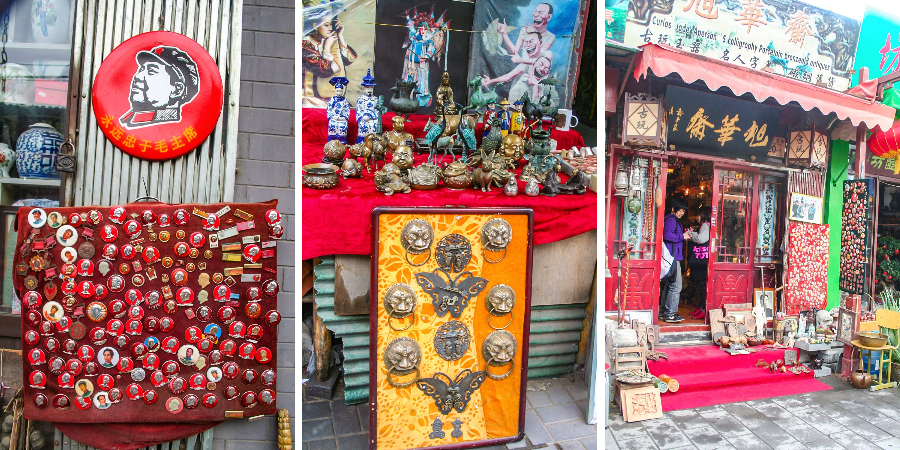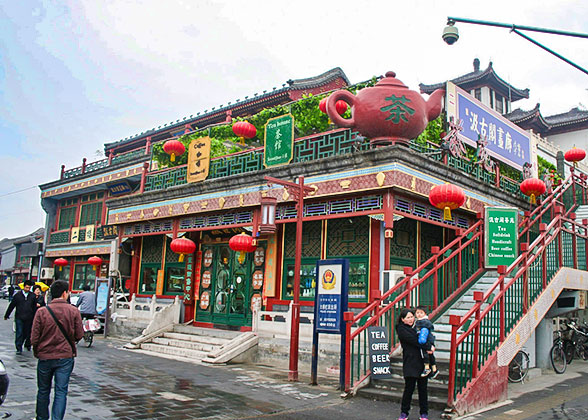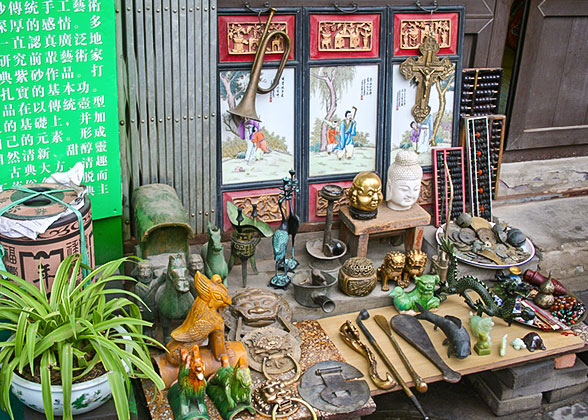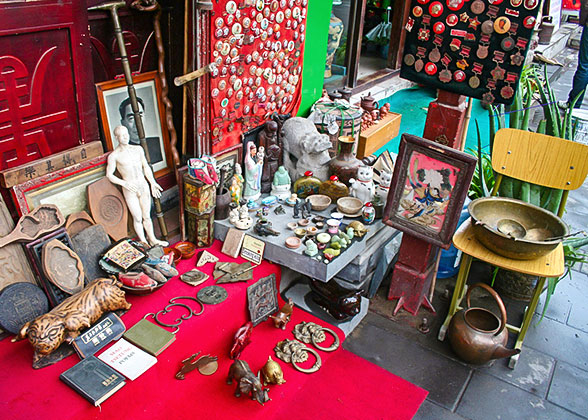If you have a favor with curios, calligraphy, painting or other artwork in China, Liulichang Cultural Street is a must see when you travel in Beijing. It literally means the Colored Glaze Factory Culture Street, and also known as Liulichang Antique Street.
The old street is located south of the Peace Gate of Xicheng District. During the time of Yuan Dynasty (1271-1368) and Ming Dynasty (1368-1644), a colored glaze factory was in production there, which made glazed tiles for the palaces, temples and residences of the officials, hence the name. In the Qing Dynasty (1644-1911), many businessmen and venders began to sell curios and old books there. Over years the factory was gradually replaced by the bazaar of calligraphy, painting, copybook, artifacts and the four treasures of the study. i.e. writing brush, ink stick, ink slab and paper. Later it fell into absence of lively atmosphere for a time until the reconstruction in the year 1982 that revived it. Now shops and houses of gray tiles and bricks together with sculptures and colored images are lined orderly by the street, making it taste more classical.
 |
| Liulichang Cultural Street, Beijing |
Rongbaozhai and China Bookshop
It is the most famous shop in Liulichang Cultural Street. Built in the early years of Qing Dynasty, it now particularly sells authentic calligraphy and paintings of both ancient and modern authors in China. It is also well-known for an expert copy technique; the products from this method cannot be easily distiguished from the original. Another also reputed across the country is the China Bookshop, where you can buy block-printed editions and hand-copied books of the ancient times.
 | | Artware sold on Liulichang Cultural Street | | |
Guanfu Classic Art Museum
As the first private museum in our country, it was opened in 1997, with displays of about 50 porcelains from the late Ming Dynasty as well as old-fashioned furniture, carpets and costumes and others of the Ming and Qing Dynasties. There you can not only appreciate the art works but also feel the history better.
Beijing Opera Remains
Liulichang Cultural Street also had often been selected as the platform for the performance of
Beijing Opera. These show buildings and assembly halls now become a bright sight of the culture of this street. This soil has nurtured many opera superstars such as the well-known Mei Lanfang, around here you can still find the former residence relics of some of them.

Changdian and Haiwangcun Park
The noisiest place you may find in the street is Changdian in its south. Since the Ming Dynasty, a large temple fair had been held for the first 16 days of the Spring Festival (Lunar Jan.1 - Jan.16). It became a custom to stroll in the fair during the
Chinese New Year. Now, this characteristic festival has been resumed after many years' decline since the end of Qing Dynasty. There is still another line of scenery in this area. Beside a branch shop of China Bookshop is the old relics of Haiwangcun Park. Built in 1917, it was the centre of bazaar and the busiest place in Changdian. Many kinds of trades were carried out here such as the metallic works, stones and curios, calligraphy, painting, photography and musical instruments. The park was also decorated with many spectacular buildings like water features, pavilions and stone carving arches. The reconstruction of the relics of the park is presently at work.
The local Municipal government has planned to invest much capital in the repair of the street. It is expected to be the earliest, largest and most aesthetic collection place of artware and a good tourist choice for the appreciation of the ancient capital.
 | | Liulichang Cultural Street | |  | | Artware Sold in the street | |
How to get to Liulichang Cultural Street
1. Take bus 7, 14, 15, 66 or 70 and get off at Liulichang Station.
2. Take
Subway Line 2 and get off at Hepingmen Station, get out of the station from Exit D1 or D2 (southwest exit), and walk south for 550 meters (600 yards).
Beijing Bus / Subway Search - Last updated on Apr. 07, 2025 by Gabby Li -

 The noisiest place you may find in the street is Changdian in its south. Since the Ming Dynasty, a large temple fair had been held for the first 16 days of the Spring Festival (Lunar Jan.1 - Jan.16). It became a custom to stroll in the fair during the Chinese New Year. Now, this characteristic festival has been resumed after many years' decline since the end of Qing Dynasty. There is still another line of scenery in this area. Beside a branch shop of China Bookshop is the old relics of Haiwangcun Park. Built in 1917, it was the centre of bazaar and the busiest place in Changdian. Many kinds of trades were carried out here such as the metallic works, stones and curios, calligraphy, painting, photography and musical instruments. The park was also decorated with many spectacular buildings like water features, pavilions and stone carving arches. The reconstruction of the relics of the park is presently at work.
The noisiest place you may find in the street is Changdian in its south. Since the Ming Dynasty, a large temple fair had been held for the first 16 days of the Spring Festival (Lunar Jan.1 - Jan.16). It became a custom to stroll in the fair during the Chinese New Year. Now, this characteristic festival has been resumed after many years' decline since the end of Qing Dynasty. There is still another line of scenery in this area. Beside a branch shop of China Bookshop is the old relics of Haiwangcun Park. Built in 1917, it was the centre of bazaar and the busiest place in Changdian. Many kinds of trades were carried out here such as the metallic works, stones and curios, calligraphy, painting, photography and musical instruments. The park was also decorated with many spectacular buildings like water features, pavilions and stone carving arches. The reconstruction of the relics of the park is presently at work.





